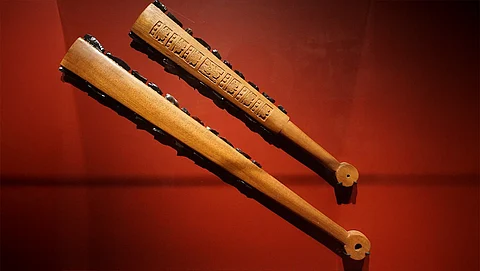

A new study has uncovered the Mesoamerican Aztec Empire’s economy built on obsidian, a volcanic glass used for tools and ceremonial objects and one of the most important raw materials in pre-Columbian times.
The study analysed 788 obsidian artifacts excavated from the Templo Mayor of Tenochtitlan, the main temple and core of the Mexica Empire located in what is now Mexico City.
Archaeologists found that while the Mexica or Aztecs mainly used green obsidian from the Sierra de Pachuca source, they also acquired obsidian from at least seven other locations, including regions beyond their political borders, such as Ucareo, in the Purépecha territory in West Mexico, a statement Tulane University in New Orleans noted.
Ninety per cent of the obsidian artifacts in the sample were made with Sierra de Pachuca obsidian. This type was prized for its green hue and symbolic connection to the mythical city of Tollan.
“Almost all the ceremonial artifacts found inside buried offerings at the Templo Mayor were made with this type of obsidian, including miniature weapons, jewelry and inlays for sculptures,” noted the statement.
A smaller but significant portion of the obsidian came from places like Otumba, Tulancingo, Ucareo and El Paraíso, some of which lay outside the control of the Mexica Empire.
“These materials were more commonly used for tool production and found in the construction fill, indicating that these obsidian types were available to the general population through local markets rather than being tightly controlled by the state,” the statement noted.
The research by Tulane University and the Proyecto Templo Mayor in Mexico also found that the use of obsidian shifted over time, from the Aztec Empire’s founding till its end at the hands of Hernan Cortes’ conquistadors.
“During the empire’s early phases, more variety in obsidian sources appeared in both ritual and everyday objects. After the Mexica consolidated power around 1430 CE, obsidian for ritual purposes became almost exclusively sourced from Sierra de Pachuca, suggesting growing religious standardization and centralized control,” noted the statement.
Compositional analysis of obsidian artifacts from the Templo Mayor of Tenochtitlan, capital of the Mexica (Aztec) Empire has been published in the journal PNAS. It is co-authored by Tulane researchers Jason Nesbitt, Julia Sjödahl and Tatsuya Murakami, and INAH (Proyecto Templo Mayor of the National Institute of Anthropology and History) researchers Leonardo López Luján, Rodolfo Aguilar Tapia and Alejandro Pastrana.